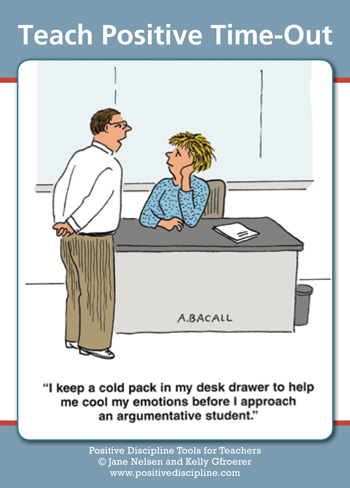Where did we ever get the crazy idea that in order to make children do better, first we have to make them feel worse? —Jane Nelsen
Research shows that punitive time-out is ineffective because forced separation from the class denies the student’s basic need for inclusion and belonging. As far back as 2004 the National Association for the Education of Young Children (NAEYC) has recommended replacing punitive time-out as well as all discipline techniques that pose pain and suffering. Instead it is recommended that teachers focus on providing guidance, teaching democratic life skills, and using encouragement in the classroom. Positive Time-Out and other Positive Discipline Tools provide these NAEYC recommended practices.
It is important to take time to train students so that they understand how Positive Time-Out can help. Students can work together to create a Positive Time-Out space. Brainstorm with the entire class to define what the Positive Time-Out space might look like. If your students need help, provide examples. For younger students the Positive Time-Out area might have cushions, books, stuffed animals, and an iPod for listening to soft music (no interactive screens), or a notebook with models of relaxation exercises for calming down. Older students may create something as elaborate as a Hawaii-themed corner with beach chairs and umbrella, a mural, and other decorative details, or something as simple as a beanbag beside a shelf with magazines and paperback books. Jared’s Cool-Out Space is a great resource to read to the class to teach the process and benefits of Positive Time-Out.
A Positive Discipline Teacher Tool Card
Tool in Action from Chicago, Illinois
Last year I had the chance to attend an incredible workshop on Positive Discipline for teachers with Béatrice Sabaté. The workshop provided me with the inspired recognition that there are reliable methods I can use to deal with the challenges I was encountering in the classroom. One of the tools that caught my attention was le temps de pause (Positive Time-Out). I thought right away about two of my students who had difficulties staying focused for a long time. Would these two students take advantage of this temps de pause? How much time would they need? Would they return to class with a refreshed ability to focus and complete their work? Would all the students use the temps de pause? I really wanted to try.
One day I explained to all the students in my group that sometimes it is difficult to be attentive for a long time and that we could create a little space to rest for a few minutes. I explained that this option was not meant for only one student for a long period of time but was meant to give all students who needed it enough time to rest. The students really liked this idea! Then each of the students chose two pictures of items they wanted to put on a poster to hang in the relaxing area. On the poster there was a basketball player in action, birds forming a heart, tropical fishes, a snake, a shark, and more. We decided together on a convenient place to put the poster, and our Positive Time-Out space was created! At the next class, I explained again the purpose of the temps de pause, and during the class (and throughout the rest of the year) I was amazed to see that only the two students who struggled to be attentive asked me for permission to have un temps de pause. Only one of the two sat by the poster and rested at a time. Looking at the pictures on the poster, these students could explore a world of the imagination that allowed them to momentarily escape the demands of their classwork. They would stay only a few minutes and then come back with the group to participate happily in the activities. The other students were not bothered at all by their brief departures. This temps de pause was so easy and quick to put in place and so useful for all of us. Everyone benefited, everything was positive, it was magic!
—Nathalie Meyfren-Rado, Lycée Français de Chicago
To read more about ways teach Positive Time-Out and read other teacher success stories about Positive Time-Out, you may pre-order Positive Discipline Tools for Teachers book.


No Comments yet!